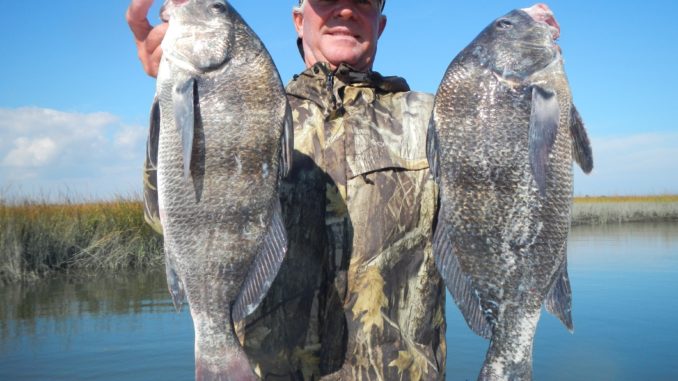
Schooling nature puts black drum in range of many inshore fishermen during the winter.
As the New Year arrives, deer season gives way to a new chapter for many sportsmen in the Tarheel State, and one of the most-overlooked inshore powerhouse fishes is readily available, tucked away in the marshes of the lower Cape Fear River.
Black drum bunch into tight schools this time of year, giving fishermen the opportunity to crack the code on this somewhat mysterious species.
For most of the year, black drum surprise anglers who are slinging shrimp for red drum and speckled trout, and they are often viewed as a bolt from the blue when they show up on the hook. But as the chilly weather and meager food supply takes its toll on fish that spend the winter inside, schools of blacks and reds intermingle, and fishermen can easily double up without moving their boats.
Black drum will typically select the deeper side of a creek, leaving the shallower sides for the red drum. Fortunately, both eat some of the same forage, making it easy for fishermen to shift back in forth when hideouts are located and identified.
While some anglers prefer to catch red drum, black drum are known to put up a courageous fight in both warm- and cold-water situations, and some anglers feel a black drum’s battle is a little more intense than the typical red drum. Either way, black drum can offer winter anglers a challenging and exciting way to spend a day at play.
Capt. Jeff Wolfe of Seahawk Inshore Fishing Charters catches his fair share of black drum throughout the year, but he really racks up on them when the winter arrives.
“I find them corralled in holes and in deeper places in creeks with some kind of structure present,” said Wolfe (910-619-9580). “I like docks and oyster beds in water anywhere from five to 15 feet deep.”
Some of the best wintertime places are deep-water refuges in the upper reaches of tidal creeks and in deep-water locales littered with structure where redfish typically hold up in cold weather. Wolfe prefers the lower end of the tide cycle for finding congregations of both black and red drum.
“When the tide gives out, the deeper pockets will fill up with fish,” he said. “I prefer to fish halfway down the tide to low and then a little of the rising tide,” he said.
Capt. Jot Owens of Jot It Down Fishing Charters catches double-digit stringers of reds and blacks on a regular basis. He fishes the falling tide but really likes the middle of the day through the afternoon during warm spells that are typical during North Carolina winters.
“Anything to warm up the water by a few degrees and excite the fish will improve your fishing dramatically in the wintertime,” said Owens (910-233-4139). “I prefer places where there is good (current) that will shake up the water and bring food to the fish.”
Black drum cruise the edges of structure, picking off anything that scoots along the shell growth. These striped powerhouses are bottom feeders that prefer shrimp, sand fleas and crabs, but they will eat oysters, barnacles and marsh mussels when other foods are unavailable. The teeth covering the arch of their throat allow these fish to crush through the hard exoskeletons of these crustaceans. During the winter, most of the shrimp and crabs have vacated the region, and there are fewer preferred items on the menu to fill their bellies.
“There is plenty to eat during the summer that keeps them spread out all over the place,” Owens said, “but the fish get more concentrated in the winter because their foods of choice — shrimp and crab — get scarce, and these fish are much easier to finesse with bait when they are concentrated. If you pick up one, drop your Power Pole; they will be packed up tight in that spot. It is rare for a black drum to travel alone this time of year.”
Owens takes advantage of nature’s limited food supplies to provide the right kind of menu. He goes with small pieces of cut shrimp with the shells removed.
“For some reason, the naked shrimp is much better than a shrimp with the head on,” he says.
Beyond shrimp, small pieces of cut blue crab will also entice a bite from black drum.
Owens uses a small, clip-on float and a 2/0 bait-holder hook or a Carolina rig. Even though fish are hungry, the water is old and clear. He prefers to use a 24-inch section of 30-pound fluorocarbon leader, and he will also fish small pieces of shrimp on ¼-ounce jigheads.
Typically, black drum are best caught on fresh shrimp, but Owens and Wolfe will use 3-inch Gulp! shrimp in lighter hues, including sugar spice glow, natural, and molting.
“The water is so clear, the lighter colors worth the best, but I even use the sugar spice/glow in murky water. It has a real natural look to it and the fish seem to bite it under a variety of clarity conditions,” Owens said.
The lower Cape Fear region generally includes the waters around Southport, Fort Fisher, Bald Head Island and Oak Island, but Snow’s Cut located just upstream from Fort Fisher connects the Lower Cape Fear with the salt-rich paradises of Carolina Beach and Wrightsville Beach. Anglers fishing the region can gain access to a wide variety of habitats with varied levels of salinity. Black drum and many of the other popular inshore favorites will stay in areas where conditions are the most conducive for holding bait over the winter months.
Owens targets these grounds when water temperatures drop to winter levels.
“I shy towards areas with more saltwater during winter. Any of the creeks closer to the inlet and the ocean will have more bait available,” he said.
DESTINATION INFORMATION
HOW TO GET THERE/ WHEN TO GO — The lower Cape Fear is best accessed from the Dutchman Creek Park landing in Southport, a mile east of NC 133, the N.C. Wildlife Resources Commission Landing at Snow’s Cut off US 421 and the public ramp at Fort Fisher at the end of US 421. The best black drum/red drum combo fishing is from November through April, or as long as the water temperature rests between the upper 40s and lower 60s. Try to fish the last three hours of the falling tide and the first hour of the rising tide. Concentrate on deeper creeks and deep structure near docks and marinas.
BAITS/TECHNIQUES — Small pieces of shrimp are preferred, without the shell or head, fished on a 2/0 hook as part of a Carolina rig, under a float rig or threaded onto a ¼-ounce jighead. Scented soft-plastic lures, such as a 3-inch Gulp! shrimp in molting, natural and sugar spice/glow colors rigged on a red, white, black or gray ¼-ounce jighead. Baits should be fished very slowly along the bottom with a stop and go retrieve with long pauses between retrieves to get the best results.
TACKLE/GEAR — Spinning gear is preferred: 7-foot medium to medium-heavy outfits spooled with 14- to 20-pound braid with an 18- to 24-inch fluorocarbon leader.
GUIDES/FISHING INFO — Capt. Jot Owens, Jot It Down Fishing Charters, 910-233-4139, www.captainjot.com; Capt. Jeff Wolfe, Capt. Christian Wolfe, Seahawk Inshore Charters, 910-233-4139, www.seahawkinshorefishingcharters.com. See also Guides and Charters in Classifieds.
MAPS — Navionics, 800-848-5896, www.navionics.com; The Good Spots, 800-411-0185, www.thegoodspots.com; Grease Charts www.greasechart.com; GMCO, 888-420-6277, www.gmcomaps.com.
ACCOMMODATIONS — Brunswick County Vacation Guide, 910-755-5517, www.ncbrunswick.com; Wilmington and Beaches Convention and Visitors Bureau, 877-406-2356, www.wilmingtonandbeaches.com; The Official Travel & Tourism Website for North Carolina, www.visitnc.com.

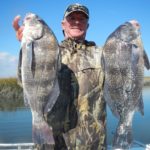
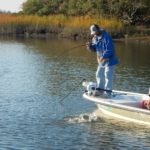
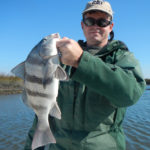
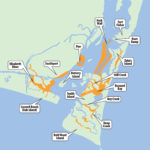




Be the first to comment